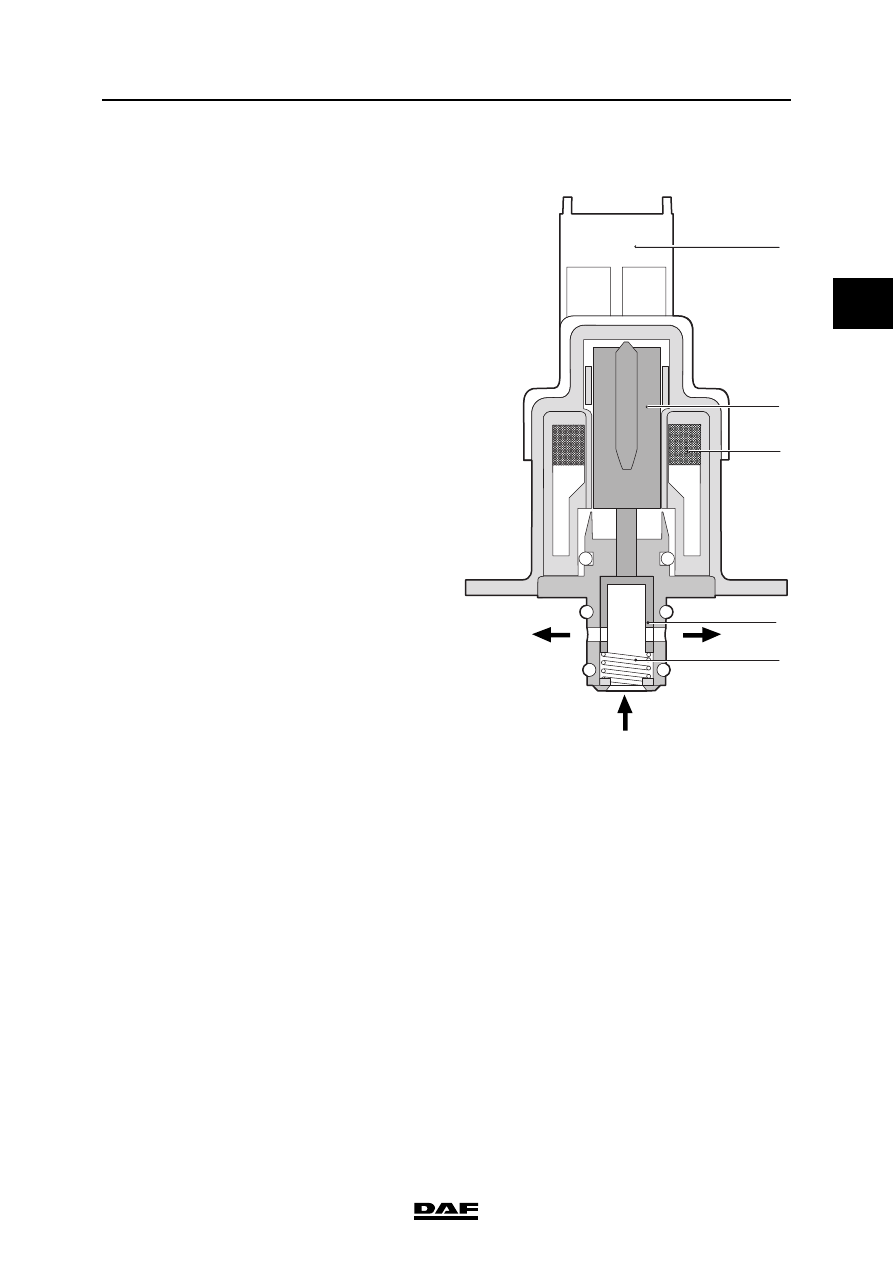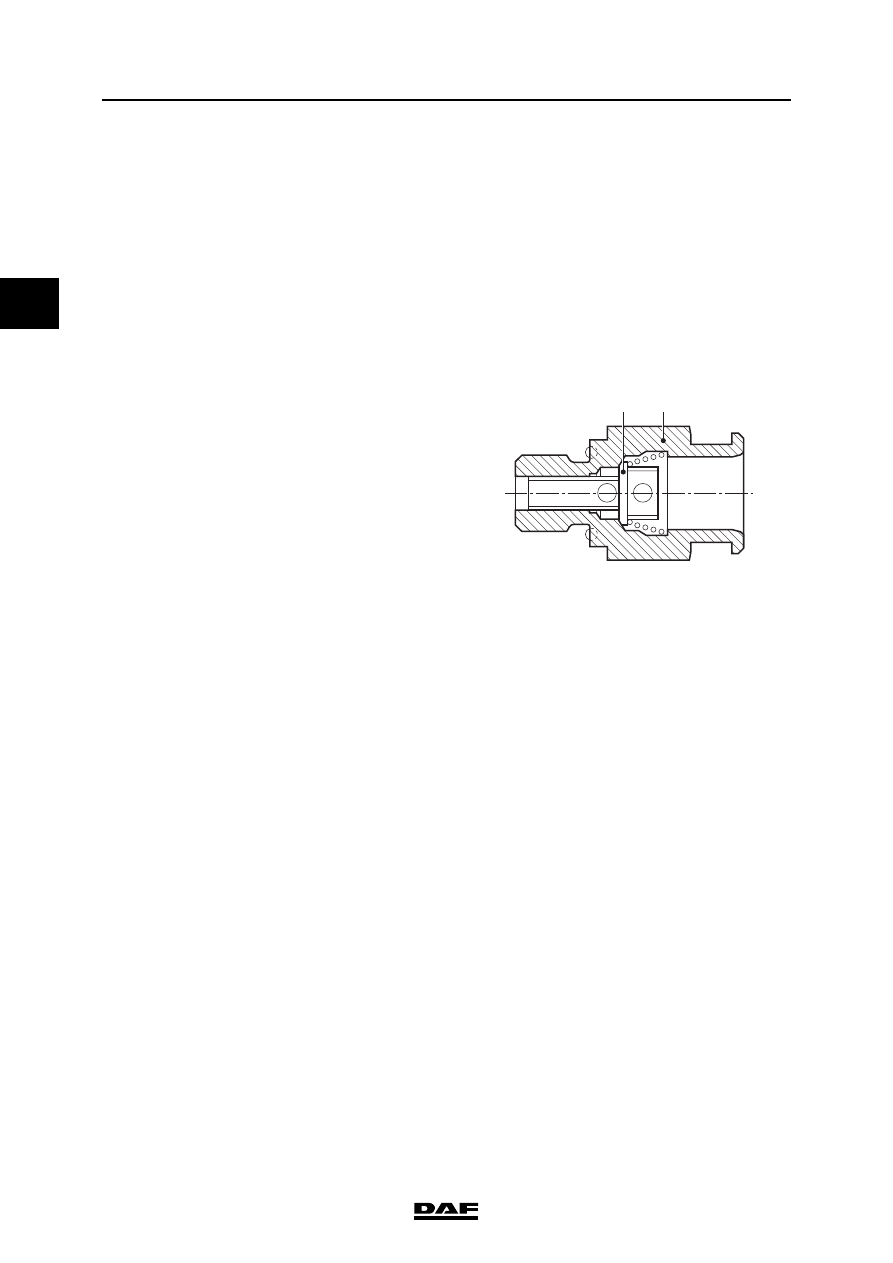DAF LF45, LF55 Series. Manual — part 290

©
200416
3-3
Description of components
BE ENGINE FUEL SYSTEM
ΛΦ45/55 series
4
2
3.2 FUEL PUMP CONTROL SOLENOID VALVE
The high-pressure pump has an over-capacity for
normal operating conditions. This could lead to
large quantities of fuel being forced at high
pressure to the fuel rail and then directly being
drained out to the return pipe via the pressure-
limiting valve on the fuel rail. This produces too
much unnecessary heat and loss of capacity
because large amounts of fuel are flowing at high
pressure.
The system has been designed such that only
fuel that will be used will be forced under high
pressure to the rail. For this reason, a fuel pump
control solenoid valve has been fitted at the
suction side of the high-pressure pump. This
solenoid valve is opened without being
energised, so that the high-pressure pump
elements can be filled in the normal manner.
If the fuel rail pressure becomes too high, for
example because of lower fuel off-take on the rail,
the solenoid valve will be energised by the
electronic unit with a higher duty cycle, so that the
plunger is pressed with a greater force against
the spring pressure and the valve reveals a more
constricted opening. This reduces the fuel supply
to the pump elements and the pump output will
thus fall. The fuel rail pressure will also fall as a
consequence.
If the rail pressure is too low, the reverse is true.
The current is supplied to the coil (3) via the
connector (1). The current pushes the core (2)
with the plunger (4) against the pressure of the
spring (5). This controls the fuel current from
input A to output B.
Due to this valve, under normal circumstances
very little fuel flows back from the rail. This
improves performance and reduces the
generation of heat.
B
A
B
i400591
1
2
3
5
4

BE ENGINE FUEL SYSTEM
3-4
©
200416
Description of components
2
ΛΦ45/55 series
4
3.3 INJECTOR
The injectors can be opened and closed
electrically. The injector is normally closed. The
load of the spring (2) and the fuel rail pressure
that controls chamber C ensure this.
The fuel is supplied from the fuel rail via A. The
return fuel can flow back to the fuel tank via B.
When the coil (7) is energised, the armature
housing (5) moves up. As a result the pressure in
chamber C drops slightly and the injector needle
(1) is forced up to chamber D by the rail pressure.
The fuel can then be injected.
7
C
E
A
B
F
D
6
5
4
3
2
1
I400548

©
200416
3-5
Description of components
BE ENGINE FUEL SYSTEM
ΛΦ45/55 series
4
2
3.4 FUEL RAIL PRESSURE-LIMITING VALVE
The fuel rail has a pressure-limiting valve so that
the rail pressure is maintained at a safe value in
emergency situations.
The fuel rail pressure control circuit is normally
active. This consists of the fuel lift pump, fuel
pump control solenoid valve, high-pressure
pump, fuel rail, rail pressure sensor and
electronic unit. If a fault occurs, the rail pressure
can no longer be controlled. This can rise to the
actuating pressure of the fuel rail pressure-
limiting valve. This pressure is approx. 1650 bar.
In the open position all surplus fuel flows without
pressure to the fuel tank return connection.
The valve includes a sealing cone (1), a valve
body (2), a spring (3) and a return connection with
quick-release coupling (4).
i400592
1
2
3
4

BE ENGINE FUEL SYSTEM
3-6
©
200416
Description of components
2
ΛΦ45/55 series
4
3.5 FUEL RETURN OVERFLOW VALVE
The injectors are mounted in the cylinder head.
The injectors do not have a separate return
connection. In place of this there is a longitudinal
bore in the cylinder head that meets the injector
bores of all cylinders coinciding with the height of
the return ports of the injectors. A pressure relief
valve is mounted at the end of the bore to prevent
vapour bubbles forming in it and to prevent it
emptying after the engine is turned off. This valve
maintains a residual pressure in relation to the
return pressure of 1.2 to 2.0 bar.
The pressure relief valve consists of a spring-
loaded plunger (1) and a housing (2) with quick-
release inlet and outlet connections (A and B
respectively).
A
B
1
2
i400861

Нет комментариевНе стесняйтесь поделиться с нами вашим ценным мнением.
Текст